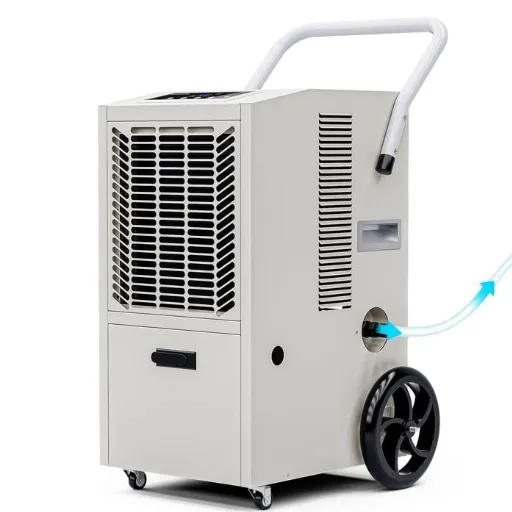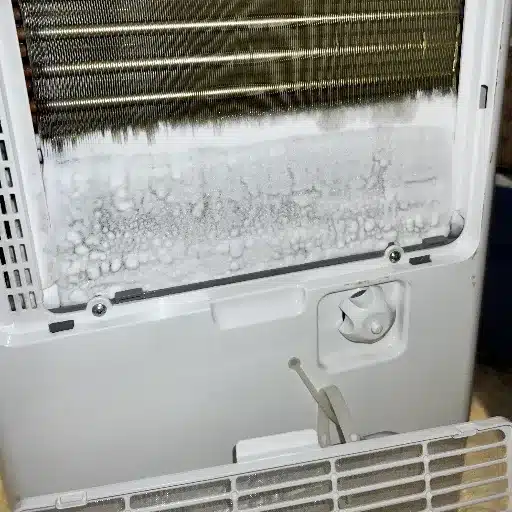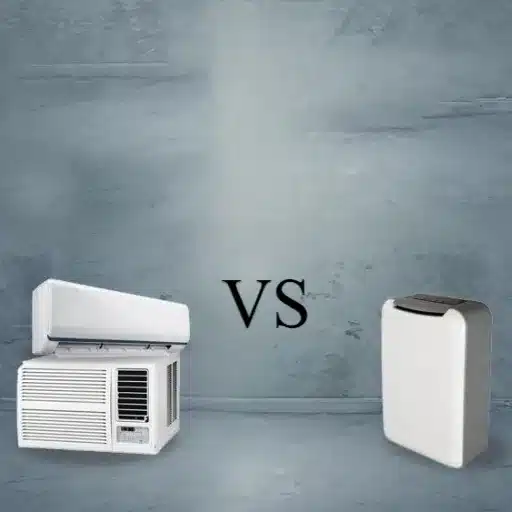Water damage can be a homeowner’s nightmare, leading to costly repairs, structural issues, and even health hazards if left unresolved. But what if there was a powerful tool to combat this challenge head-on? Enter the dehumidifier—a device that does far more than just reduce indoor humidity. This blog explores the critical role dehumidifiers play in water damage restoration, from preventing mold growth to safeguarding your property’s integrity. Whether you’re addressing the aftermath of a flood, a plumbing disaster, or excess moisture caused by poor ventilation, understanding how dehumidifiers work can be the key to restoring normalcy quickly and effectively. Read on to uncover how this essential tool can transform the water damage restoration process and protect what matters most.
What is a Dehumidifier and How Does it Work?
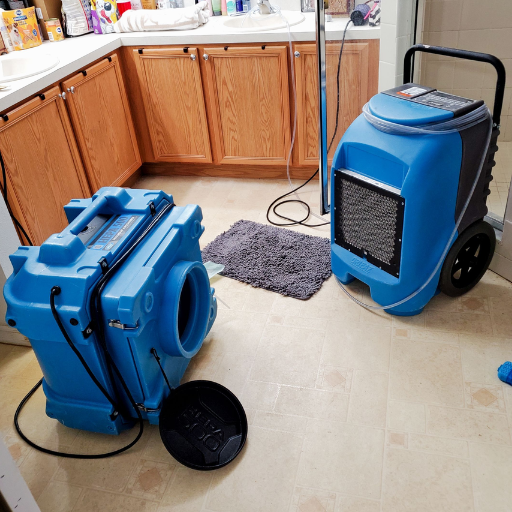
A dehumidifier is an appliance made to control the level of moisture in the surrounding environment. A dehumidifier works by sucking in humid air, cooling it to condense moisture into water, and releasing the dry air back into the environment. By minimizing excess humidity, a dehumidifier can prevent issues such as mold growth, musty smells, as well as damage wood and structures from moisture. They are easy to operate which is essential for maintaining a healthy indoor environment. Dehumidifiers are best suited for areas that are damp or have high humidity.
Understanding the Basics of a Dehumidifier
Dehumidifiers operate by drawing in air from the environment and removing the excess humidity through condensation. The machine then blows the drier air back into the room. They are effective in controlling the growth of mold, mildew, and moisture related allergens. These are found in homes, and basements as well as places where humidity is constantly high. Dehumidifiers also enhance the air quality and protect the health of the occupants as well as the house. This improves internal conditions.
The Role of Humidity in Water Damage Restoration
Humidity plays a critical role in the process of water damage restoration, as it directly influences the drying speed and overall recovery of affected areas. High humidity levels can slow down the evaporation process, leading to prolonged moisture retention and increasing the risk of secondary damage such as mold growth and material degradation. Studies indicate that indoor humidity levels should ideally be maintained between 30% and 50% to create optimal conditions for drying and prevent further issues.
Advanced tools, such as hygrometers, are used during restoration to measure and monitor humidity levels accurately. Dehumidifiers are then employed to extract excess moisture from the air, ensuring quicker and more efficient drying. For instance, industrial-grade dehumidifiers boast high moisture removal capacities, with models capable of extracting over 70 pints of water per day, making them invaluable for large-scale restorations.
Additionally, controlling humidity is essential for minimizing health risks associated with water damage. Elevated humidity fosters an environment where mold spores can thrive within 24-48 hours, releasing allergens and potential toxins into the air. By reducing humidity levels and promoting airflow with equipment like air movers and dehumidifiers, restoration professionals mitigate these risks, ensuring a safer and healthier indoor environment for occupants.
Effective humidity control is not just about facilitating the drying process but also about preventing long-term issues, making it a key factor in successful water damage restoration.
How to Use a Dehumidifier Effectively
To maximize the efficiency of a dehumidifier and maintain an optimal indoor environment, follow these best practices:
- Choose the Right Size
Selecting the correct dehumidifier for your space is crucial. Dehumidifiers are typically rated by their capacity to remove moisture, measured in pints per day. For instance, a small 500-square-foot room with high humidity may require a 20-30 pint capacity dehumidifier, while larger areas, exceeding 2,000 square feet, might need units capable of extracting 50-70 pints daily. This ensures proper coverage and effective moisture control.
- Placement Matters
Place the dehumidifier in a central yet unobstructed location where airflow isn’t restricted. Keep it at least 6-12 inches away from walls or furniture to allow adequate ventilation. For flood-damaged areas, positioning the unit near the source of the damage can enhance drying speed.
- Set the Ideal Humidity Level
Maintain indoor humidity levels between 30% and 50% for optimal comfort and to prevent mold growth. Most modern dehumidifiers come with adjustable settings and built-in hygrometers that allow you to monitor and control humidity levels with precision.
- Keep Filters Clean
Regularly check and clean the unit’s air filter. A clogged filter reduces efficiency and increases energy consumption. Replace filters periodically based on the manufacturer’s recommendations to maintain peak performance.
- Empty the Reservoir or Use Continuous Drainage
Dehumidifiers typically collect extracted moisture into a reservoir that needs regular emptying. To avoid frequent manual draining, consider models with a continuous drainage option, connecting the unit to a sink or sump pump for effortless operation.
- Enhance Air Circulation
Pair the dehumidifier with fans or open windows (if outdoor humidity is low) to improve airflow. This accelerates moisture extraction and reduces drying time in damp spaces.
- Energy Efficiency Tips
Utilize energy-efficient models certified by ENERGY STAR® to lower operating costs. Additionally, only run the dehumidifier when necessary, and consider units with auto-shutoff features to minimize power consumption.
By adhering to these guidelines, you’ll optimize your dehumidifier’s function, efficiently control moisture, and maintain a healthier indoor environment, particularly in areas prone to dampness or water damage.
Why Do You Need a Dehumidifier for Water Damage?
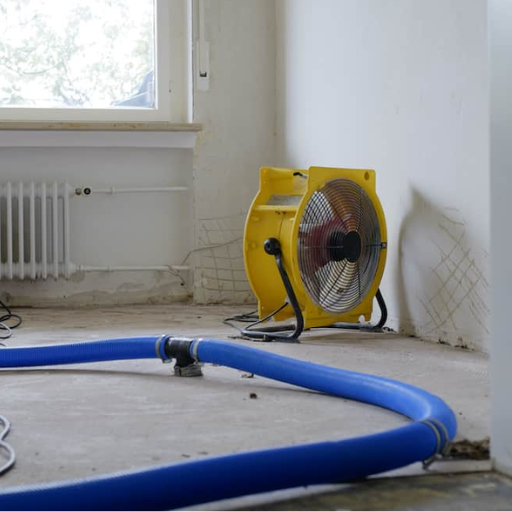
A dehumidifier is essential for addressing water damage because it helps remove excess moisture from the air, preventing the growth of mold and mildew. By reducing humidity levels, it also aids in drying out walls, floors, and furniture more quickly, minimizing long-term structural damage. Using a dehumidifier creates a healthier indoor environment, as high moisture can lead to poor air quality and health concerns like allergies or respiratory issues. This makes it a crucial tool for restoring and maintaining your home after water damage.
Preventing Mold Growth and Further Damage
Mold growth is a common consequence of untreated water damage, often beginning within 24 to 48 hours of high humidity exposure. Elevated moisture levels create an ideal environment for mold spores to thrive on surfaces like wood, drywall, and carpets. A dehumidifier plays a critical role in controlling this issue by reducing indoor humidity to below 50%, a level where mold struggles to grow.
Studies indicate that moisture control is the most effective strategy for mitigating mold risks. Prolonged water exposure can also weaken the structural integrity of materials such as wooden beams, drywall, and insulation, potentially leading to costly repairs. By accelerating the drying process, dehumidifiers not only halt the spread of mold but also safeguard your home from rot, warping, and breakdown of building materials.
Modern dehumidifiers are designed with advanced sensors and energy-efficient technology, allowing them to regulate humidity levels effectively while minimizing electricity usage. This ensures continuous protection without significantly increasing energy bills. When combined with proper ventilation and proactive monitoring, using a dehumidifier becomes a key step in preventing long-term health hazards and structural deterioration due to excess moisture.
The Importance of Humidity Control
Maintaining proper indoor humidity levels is crucial for both health and home preservation. Studies show that the ideal indoor humidity range is between 30-50%, as levels outside this range can lead to several issues. High humidity fosters the growth of mold, mildew, and dust mites, all of which can trigger allergies and respiratory problems. On the other hand, overly dry air can lead to skin irritation, respiratory discomfort, and even damage to wooden furniture or flooring due to cracking and shrinking.
A well-regulated humidity environment also contributes to energy efficiency. Air that is too humid feels warmer, prompting excessive use of air conditioning, which increases utility costs. Proper humidity not only reduces this dependency but also ensures a more comfortable living environment. Leaks, condensation, and poor insulation are common culprits for indoor humidity imbalance, and advanced humidity control solutions are now equipped to address these issues intelligently, making homes safer and more efficient to live in.
Recent advancements in dehumidifier technology allow for precise humidity adjustments, integrated air filtration, and real-time monitoring. These features ensure mold prevention, reduce allergens, and create healthier indoor conditions, showcasing the importance of adopting humidity control systems as part of modern home management.
How a Dehumidifier for Water Damage Restoration Can Remove Water
Dehumidifiers play a critical role in water damage restoration by efficiently extracting excess moisture from the air and impacted spaces. When an indoor area is subjected to water damage, whether due to leaks, flooding, or high humidity, it creates an environment conducive to mold growth, structural degradation, and odor buildup. By reducing humidity levels rapidly and consistently, dehumidifiers help mitigate these risks and restore a safe, habitable space.
Modern dehumidifiers utilize advanced technology to accelerate water removal. High-capacity units, for instance, are capable of extracting up to 70 pints of water per day, depending on the model and environmental conditions. Refrigerant-based dehumidifiers condense moisture from the air onto cold coils, while desiccant dehumidifiers absorb water using a drying material, making them highly effective even in lower temperatures.
Additionally, some dehumidifiers are equipped with built-in hygrometers and smart sensors, enabling automatic adjustments to maintain optimal humidity levels, often between 30% and 50%, as recommended by the Environmental Protection Agency (EPA). Paired with air movers and industrial-grade fans, dehumidifiers significantly speed up the drying process in water-damaged rooms, reducing overall restoration time and preventing further structural damage.
This combination of power and precision not only enhances water removal efficiency but also ensures that materials such as drywall, wood flooring, and carpets are properly preserved. Investing in a high-performance dehumidifier is essential for both DIY and professional restoration projects, offering long-term savings and safeguarding indoor air quality.
How to Choose the Right Dehumidifier for Your Needs
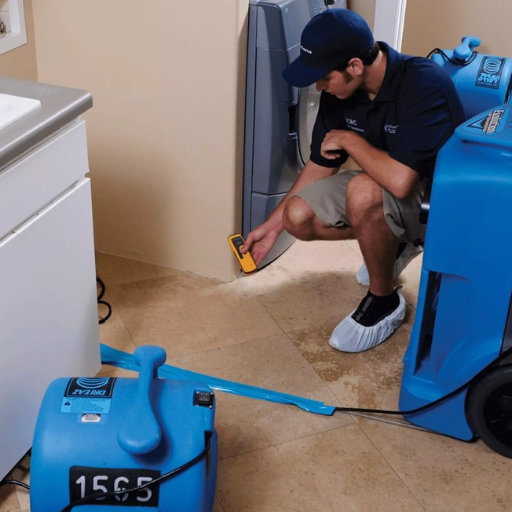
To pick the best dehumidifier, start by determining the area’s size and moisture problem. If you are dealing with a smaller room like a closet or a bathroom, a portable, low-capacity dehumidifier will do the job. However, for larger rooms like basements or living rooms, a higher-capacity unit (measured in pints per day) should be considered.
Also, look for adaptable features like adjustable humidity controls, energy efficiency, and quick portability. If the space faces constant high humidity or water-related problems, consider models with standard drainage and automatic shut off. Make sure that the dehumidifier has filters that are easy to clean, as this helps lower down maintenance, while still preserving performance and air quality.
Factors to Consider: Pint Capacity and Commercial Dehumidifier with Pump
When selecting a dehumidifier, pint capacity is a critical factor to assess. Pint capacity refers to the amount of moisture the dehumidifier can remove from the air in a 24-hour period. For small to medium-sized areas, such as bedrooms or offices, a unit rated at 20-30 pints per day is sufficient. For larger spaces, such as basements or open-concept areas, consider models with a capacity of 50 pints or more to ensure efficient moisture removal. High-capacity units are especially beneficial for spaces prone to excessive humidity or dampness, as they are capable of managing moisture levels more effectively.
For industrial or large-scale applications, a commercial dehumidifier with a pump is often essential. These models are built to handle significantly larger volumes of moisture and are ideal for water damage restoration, construction sites, or spacious warehouses. A built-in pump allows for continuous drainage, making it convenient to use in areas with high humidity or where frequent manual emptying of the water tank is impractical. For instance, commercial dehumidifiers can typically extract up to 100 pints or more per day, delivering powerful performance for demanding environments.
Efficiency and durability are key aspects of commercial models. Look for designs with metal casings and high-quality compressors to withstand frequent use. Many high-end models also incorporate user-friendly controls, digital humidity displays, and programmable settings, allowing for precise adjustment to meet specific needs. Combined with features like easy-mobility caster wheels, automatic defrost, and washable filters, these dehumidifiers provide a reliable, long-term solution for managing excessive moisture in larger spaces. Select a unit that balances capacity and functionality to maintain optimal air quality efficiently.
Understanding Refrigerant vs. Desiccant Dehumidifiers
Refrigerant Dehumidifiers
Refrigerant dehumidifiers, also known as compressor dehumidifiers, operate by condensing moisture from the air onto cold coils. They are highly effective in warm and humid environments, making them an ideal choice for spaces like basements, laundry rooms, or tropical regions.
- Optimal Operating Conditions: Best suited for temperatures above 60°F (15°C) and humidity levels over 60%. Their efficiency decreases in cooler environments.
- Energy Efficiency: These dehumidifiers typically consume less energy when used in warm climates, offering cost-effective performance.
- Capacity: They come in a wide range of moisture removal capacities, from portable units capable of handling small spaces to larger, more powerful models for commercial use.
- Noise Levels: Due to the compressor, refrigerant dehumidifiers may produce moderate levels of noise, which is something to consider for residential applications.
- Maintenance: Regular maintenance, such as cleaning filters and occasionally draining water reservoirs, is required to keep the unit functioning efficiently.
Desiccant Dehumidifiers
Desiccant dehumidifiers utilize a desiccant material, such as silica gel, to absorb excess moisture from the air. These devices excel in colder climates and applications where low temperature and low noise are key considerations.
- Optimal Operating Conditions: Ideal for environments below 60°F (15°C), as their performance remains consistent in cooler temperatures. They are particularly effective for garages, storage spaces, or during winter months.
- Energy Consumption: Desiccant models tend to use more energy than refrigerant models of similar capacity, especially when used in warmer conditions.
- Portability and Weight: Lightweight and compact, desiccant dehumidifiers are easy to move and set up in different spaces.
- Low Noise Operation: These units run quietly, making them a great option for bedrooms or offices where minimal disturbance is desired.
- Moisture Removal Capacity: While effective, desiccant dehumidifiers usually have a lower moisture removal capacity compared to refrigerant models, which may require longer running periods in highly humid spaces.
When to Opt for Portable Dehumidifier or Crawl Space Dehumidifier
The selection of either a portable dehumidifier or a crawl space dehumidifier is contingent upon the particular setting, humidity levels, and requirements for use.
Portable Dehumidifier: Ideal for smaller, enclosed spaces like bedrooms, living rooms, or home offices, where mobility and versatility are especially important. Depending on the unit and weather conditions, these units can usually eliminate 20 to 50 pints of moisture in a single day. For simpler humidity control, they can be easily transported to various locations. Portable dehumidifiers tend to be cheaper, making them perfect for most households.
Crawl Space Dehumidifier: Built to suit low-access locations such as crawl spaces or basements, these units are specially made to control dampness and high humidity levels. With durable construction, these dehumidifiers also have higher moisture removal rates, usually from 50 to well above 100 pints per day. Crawl space dehumidifiers also excel at low temperature conditions, providing energy-efficient solutions in the damp, moldy spaces. Although they need to be professionally installed most cases, these dehumidifiers are a great long-term investment to control harmful humidity levels, improve air quality, and reduce structural damage in the home.
For Daily Use: If you want flexibility, low cost, and easy to move around with, get a portable dehumidifier. But for places with severe or chronic humidity problems, especially in basements or crawl spaces, a crawl space dehumidifier is the better option because of its efficiency and durability.
How Long Should You Run a Dehumidifier for Effective Results?
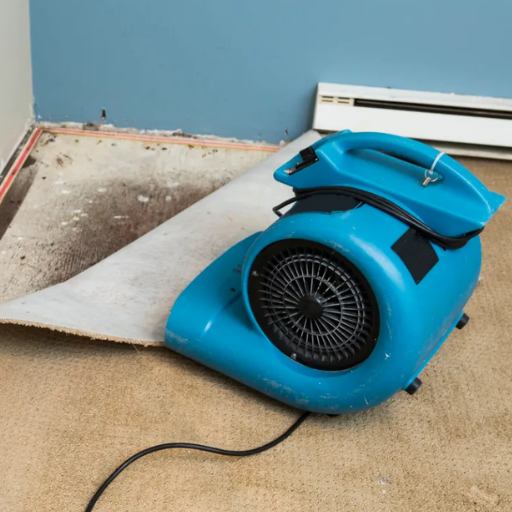
The ideal duration for running a dehumidifier depends on the humidity level and the specific needs of your space. Typically, running a dehumidifier for 10 to 12 hours a day is sufficient to maintain optimal indoor humidity levels (around 30-50%). Initially, in highly damp areas, you may need to run it continuously until the moisture levels are under control. Afterward, you can adjust usage based on a built-in humidistat, if available, to maintain consistent and efficient performance.
Determining the Humidity Level and Duration
To determine the ideal humidity level and appropriate duration for running a dehumidifier, it is essential to consider various factors such as climate, room size, and specific applications. For instance, regions with tropical or coastal climates naturally experience higher humidity levels, often exceeding 70%. These areas may require more frequent dehumidifier use to maintain indoor humidity within the optimal range of 30% to 50%. Conversely, drier regions may need less frequent operation.
Room size significantly influences the dehumidifier’s efficiency. A small room (e.g., 100-250 square feet) may only require a dehumidifier with a capacity of 20-30 pints per day, while larger spaces (e.g., 1,500 square feet or more) could demand capacities of 50 pints or higher. Additionally, spaces like basements or bathrooms, which are prone to extra moisture due to poor ventilation or water usage, often present unique challenges, necessitating longer or more consistent operation times.
For durations, a general guideline is to run the dehumidifier for 10–12 hours a day in problematic areas or during times of high humidity, such as rainy seasons. Advanced dehumidifiers equipped with hygrometers make this process simpler by automatically regulating their operation based on the detected room humidity. This prevents overuse and energy waste while ensuring the air does not become excessively dry. By tailoring the runtime to the current environmental and spatial conditions, you can optimize both comfort and energy efficiency.
Signs that Dehumidification is Complete
Determining when dehumidification is complete requires attention to specific indicators that signal the air has reached an optimal humidity level. Here are the key signs to look for:
- Stable Humidity Levels
An indoor humidity level between 30% and 50% is generally considered ideal for health and comfort. Most advanced dehumidifiers come equipped with built-in hygrometers, or you can use a separate humidity gauge to monitor levels. Once the reading stabilizes within this range, dehumidification is effectively complete.
- Reduction in Musty Odors
Excess moisture often leads to musty or damp odors, particularly in basements or other enclosed spaces. If these odors dissipate and no longer linger, it is a strong indicator that the air has reached a balanced humidity level.
- Absence of Visible Condensation
Windows, walls, or floors that previously exhibited fogging, dripping, or dampness should no longer show these signs. The absence of condensation signals that moisture in the air has been effectively reduced.
- Comfortable Indoor Environment
A properly dehumidified space feels noticeably more comfortable. You may observe less stickiness in the air and improved cooling efficiency if you are using an air conditioning system. Reduced humidity also minimizes issues like difficulty breathing or skin irritation caused by excess moisture.
- Dry Walls and Surfaces
Walls, fabrics, and other items in the room may feel dry to the touch rather than clammy or damp. This is a clear indication that excess moisture has been eliminated from the environment.
- Mold and Mildew Prevention
Over time, maintaining proper humidity levels prevents the growth of mold and mildew. If you no longer see evidence of these problems, it confirms successful dehumidification.
Maintenance Tips to Run the Dehumidifier Efficiently
- Clean the Air Filter Regularly
A clogged air filter can reduce the efficiency of your dehumidifier significantly. Check the filter at least once a month and clean it if necessary. Many modern dehumidifiers come with removable, washable filters, which typically last between 6 to 12 months. Proper maintenance of the filter not only optimizes performance but also extends the life of the appliance.
- Empty the Water Tank Frequently
Depending on the humidity level in your space, the water tank may fill up more quickly than expected. To prevent the dehumidifier from shutting off automatically, empty the tank whenever it’s full. For convenience, some models come equipped with continuous drain options that allow you to attach a hose for automatic drainage.
For most homes, keeping the relative humidity between 30% and 50% is ideal for comfort and mold prevention. Many dehumidifiers allow you to adjust the desired humidity level. Setting it too low can overwork the machine and increase energy consumption unnecessarily.
- Keep Doors and Windows Closed
To maximize efficiency, close all doors and windows in the room while the dehumidifier is running. This prevents external humidity from interfering with the unit’s performance, allowing it to work on the targeted air within the enclosed space.
- Position the Unit Properly
Place your dehumidifier in an area where air circulation is unobstructed. Ideally, maintain at least 6–12 inches of clearance on all sides to ensure optimal airflow. Avoid placing the unit directly against walls or furniture, as this can restrict efficiency.
- Inspect for Frost Build-Up
If you’re using a dehumidifier in a cold environment (below 65°F or 18°C), frost can accumulate on the coils, reducing performance. Opt for a model with an auto-defrost feature or ensure that the surrounding temperature meets the unit’s operating requirements. Dehumidifiers designed for low temperatures are better for basements and colder climates.
- Perform Routine Coil Cleanings
The coils inside your dehumidifier can gather dust and debris over time, impairing its functionality. Cleaning the coils every few months with a soft brush or a vacuum attachment maintains peak performance and prevents contaminants from entering the air.
- Monitor Energy Consumption
Excessive energy usage can be a sign of inefficiency. Check the energy rating of your dehumidifier and replace older units with an Energy Star-certified model if required. Energy-efficient models can save up to 30% on energy costs annually while maintaining effective moisture control.
Regular care and attention to these tips ensure your dehumidifier operates at peak performance, providing a healthier and more comfortable environment while reducing energy waste.
What Challenges May Arise with Water Damage Restoration?
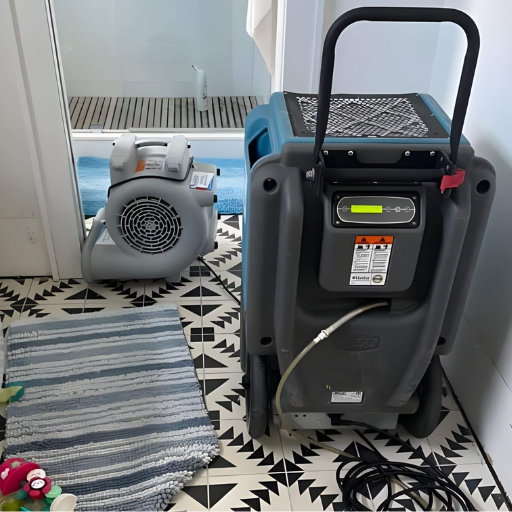
Water damage restoration presents several key challenges. One major issue is identifying the full extent of the damage, as water can easily seep into hidden areas like walls, floors, or insulation, leading to unseen structural issues or mold growth. Timely response is another challenge, as delays in addressing water damage can worsen the situation and increase restoration costs. Additionally, safely removing and drying affected materials can require specialized equipment and expertise to prevent further damage. Lastly, ensuring complete decontamination is crucial, especially if the water is classified as hazardous, such as sewage or floodwater, which may pose health risks.
Dealing with Standing Water and Carpet Restoration
Handling standing water efficiently is critical to preventing long-term damage and ensuring successful carpet restoration. The first step is to quickly remove the water using pumps, wet vacuums, or specialized extraction equipment. According to industry guidelines, it is essential to remove standing water within the first 24-48 hours to reduce the risk of mold growth, as mold spores can begin to develop rapidly in damp environments.
Once the water is removed, the focus shifts to drying and dehumidification. High-powered fans and industrial dehumidifiers should be strategically placed to enhance airflow and reduce moisture levels. Studies indicate that carpets exposed to water should be dried completely within 72 hours to prevent secondary damage, such as odor or structural weakness in the flooring.
Another critical aspect of carpet restoration is evaluating the type of water that caused the damage. For clean water from a broken pipe, carpets may often be cleaned and salvaged. However, if the water is contaminated, such as floodwater or sewage, replacement may be the safest and healthiest option due to potential health hazards. It is crucial to disinfect the affected areas thoroughly using antimicrobial treatments to eliminate bacteria, mold, and other contaminants.
Handling Water Leaks in Basement and Crawl Space
Identifying the Causes of Water Leaks
Water leaks in basements and crawl spaces are often caused by a combination of external and internal factors. Poorly graded landscaping around the foundation can direct rainwater toward the building, leading to seepage through foundation cracks. Additionally, damaged gutters and downspouts that fail to channel water away from the house can exacerbate the issue. Internally, plumbing leaks and high humidity levels in the crawl space may contribute to persistent moisture problems.
Effective Prevention Strategies
Preventing water leaks begins with proactive measures to ensure your home remains protected. Studies show that proper drainage systems around the foundation are critical for minimizing water intrusion. Installing French drains, which are gravel-filled trenches with a perforated pipe, can redirect water away effectively. Sealing foundation cracks with waterproof epoxy and applying a vapor barrier in the crawl space also significantly reduce the risk of leaks.
Advanced Waterproofing Solutions
For households prone to flooding, advanced solutions such as sump pumps and dehumidifiers provide essential protection. A sump pump automatically removes water that collects in a sump basin, a common mitigation method in areas with high groundwater tables. Modern dehumidifiers, capable of extracting up to 70 pints of moisture per day, help regulate humidity levels below 50%, which is vital to preventing mold growth in crawl spaces.
Statistical Insight into Water Damage Costs
Water damage is a widespread issue, with data indicating that approximately 98% of basements in the United States will experience some form of water damage during their lifetime. On average, homeowners spend between $1,200 and $4,500 on water damage repairs, although costs can exceed $10,000 depending on the severity. Preventative investments, such as waterproofing, can save thousands of dollars in potential damage.
By combining strategic prevention, advanced technology, and timely intervention, homeowners can successfully tackle water leaks in basements and crawl spaces, safeguarding their properties against costly damage and ensuring peace of mind.
Working with Restoration Professionals and Restoration Companies
Partnering with restoration professionals provides homeowners with access to specialized expertise and cutting-edge tools essential for addressing water damage effectively. These experts offer thorough assessments to identify the root cause of problems, ensuring that the remediation process not only resolves current issues but also prevents future damage.
Professionals rely on advanced technology, such as thermal imaging, moisture meters, and industrial-grade dehumidifiers, to evaluate and restore affected areas. For instance, high-capacity air movers can significantly reduce drying times, lowering the risk of mold growth. The Environmental Protection Agency (EPA) highlights that mold can start to form on damp materials within 24-48 hours, making immediate action by trained professionals essential.
Another significant benefit of hiring professional restoration companies is their adherence to industry standards. Reputable firms often follow guidelines set by the Institute of Inspection, Cleaning and Restoration Certification (IICRC), which ensures cleanups are performed safely and effectively. Insurance collaboration also simplifies the claims process, with many restoration companies offering assistance in documenting damage to streamline reimbursements.
According to industry reports, the water damage restoration market has grown in recent years, reflecting the increasing demand for reliable restoration services. HomeAdvisor estimates most homeowners spend between $1,200 and $5,000 on water damage repairs, with costs reaching as high as $8,000 to $10,000 for extensive damage. Engaging skilled professionals can minimize these costs by ensuring the issue is addressed thoroughly the first time.
Reference Sources
-
“Establishing the Taxonomy of Building Defects Triggered by Moisture Intrusion and Dampness”1:
- Key Findings: This study identifies various types of dampness (e.g., rising, falling, penetrating, condensation dampness) and their causes, such as faulty waterproofing, poor ventilation, and inadequate dehumidification. It highlights the role of dehumidifiers in mitigating moisture issues caused by HVAC system failures.
- Methodology: The research employed literature reviews, visual inspections, and case studies to analyze moisture-related defects in Malaysian buildings.
-
“Case Study of The Divine Shepherdess Painting”2:
- Key Findings: This case study focuses on mold growth due to water damage and emphasizes the importance of environmental control, including the use of dehumidifiers, to maintain optimal humidity levels and prevent mold proliferation.
- Methodology: The study involved visual inspections, mold sampling, and the application of chemical treatments alongside environmental adjustments using dehumidifiers.
-
“An Investigation into Noxious Circulation of Indoor Molds in Residential Apartments”3:
- Key Findings: The research underscores the health risks posed by mold in damp environments and recommends the use of dehumidifiers as a preventive measure. It also suggests incorporating antifungal substances into building materials.
- Methodology: Air and dust samples were collected and cultured to identify mold species. The study analyzed fungal loads across different building levels and proposed moisture control strategies.
Frequently Asked Questions (FAQs)
Q: How does a dehumidifier help in water damage restoration?
A: A dehumidifier is one of the essential tools for water damage restoration as it removes excess water from the air, helping to lower humidity and speed up the drying process. This prevents further damage and mold growth.
Q: What is an LGR dehumidifier and why is it important?
A: An LGR (Low Grain Refrigerant) dehumidifier is a type of restoration dehumidifier that can lower humidity levels more effectively by removing more gallons of water per day compared to standard models. This is crucial in achieving dew point and reducing saturation levels during restoration.
Q: How does a drain hose work with a dehumidifier?
A: A drain hose, often used in conjunction with a condensate pump, allows continuous drainage of condensate from the dehumidifier, eliminating the need to manually empty a water tank. This is particularly useful in large-scale water restoration projects.
Q: Why might I need a pint dehumidifier for water damage restoration?
A: A pint dehumidifier refers to the capacity of the dehumidifier to remove a certain amount of moisture per day, measured in pints. Choosing the best capacity is important to ensure it can handle the level of water saturation present in a home or business environment.
Q: What role does an HVAC system play in conjunction with dehumidifiers during restoration?
A: An HVAC system can help circulate air, which, when used with restoration dehumidifiers, can enhance the evaporation of moisture and reduce saturation, making the restoration process more efficient.
Q: How do household dehumidifiers differ from restoration equipment?
A: Household dehumidifiers are typically designed for everyday moisture control, while restoration equipment, like refrigerant dehumidifiers, is built to handle significant moisture removal needed in disaster recovery situations, such as after burst pipes or flooding.
Q: What is the importance of a pump and drain hose in dehumidification?
A: A pump and drain hose facilitate the automatic removal of water collected by the dehumidifier, which is especially important in water restoration to manage large volumes of condensate efficiently without manual intervention.
Q: How can I choose the best dehumidifier for water damage restoration?
A: To choose the best dehumidifier, consider the size of the affected area, the level of water saturation, the dehumidifier’s capacity (pint or gallon), and specific features like LGR technology or an integrated condensate pump for continuous operation.
Q: Can dehumidifiers help with invisible water damage?
A: Yes, dehumidifiers are effective in removing invisible water from the air, thus preventing potential damage and mold that may not be immediately visible but can occur due to prolonged high humidity and saturation.

